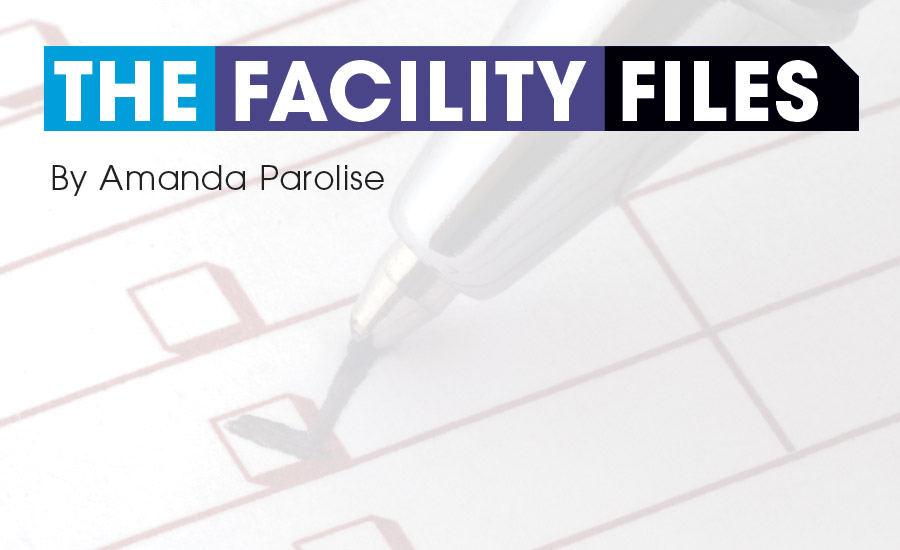This month’s Facility File will focus on the B2B June test for the renovation of an office building located on a major corporation’s U.S. headquarters campus. The existing HVAC system to be replaced is an antiquated hot water heating system serving baseboard radiation, unit heaters, and a rooftop HVAC unit.
This single-story building is scheduled to be renovated into an open office concept, and the HVAC system will have a direct outside air system (DOAS) with gas-fired heat and direct expansion cooling supply air to active chilled beams. Supply air to active chilled beams shall receive supplemental cooling via a 60-ton, air-cooled chiller providing 55ºF chilled water supply connections at each active chilled beam. Hot water radiant heat panels, located around the perimeter of the building, will be served by a 600-MBH condensing boiler providing 125º hot water supply to these panel.
The project delivery is design-bid-build (DBB), so there will be little interaction between the owner, outsourced O&M staff, design team, and the DBB general contractor and his subcontractors. The design engineer will specify in the contract bid documents the method of data collection of equipment in a manner that will make seamless the compilation of the preventive maintenance (PM) work orders to populate the existing corporate campus CMMS system to have work orders ready for day one of owner occupancy.
The building owner did not retain an owner representative but did retain a third-party commissioning and testing, adjusting, and balancing consultant (CxTAB) to assist in system verification and functional performance.
It will be beneficial for the owner and the outsourced O&M staff to have access to 2019 ASHRAE Handbook — HVAC Applications Chapter 3 (Commercial and Public Buildings), 2016 ASHRAE Handbook — HVAC Systems and Equipment Chapter 5 (In-Room Terminal Systems) for active chilled beam discussion, and Chapter 6 (Radiant Heating and Cooling) for radiant heat design considerations. The O&M staff will also reference Chapter 32 for boilers and Chapter 43 on liquid chiller systems for design considerations. In addition, the design team and owner’s outsourced O&M technician staff shall review Chapters 36-43 (Building Operation and Management) and Chapter 61 (HVAC Security) for design guidelines to assist in the training in the design phase.
In the design phase of the project, the outsourced O&M staff will want to contribute information to the design team’s writing of the contract specification and more specifically service contracts, parts inventory, and as-built drawings requirements. They’ll also want to review the design documents and gain assurance equipment serviceability will be adequate.
For a building program as well as a business plan to continue to successfully manage the corporate offices on this campus, energy management and the new radiant HVAC and DOAS will contribute to this ongoing success. Occupant comfort within the building itself is imperative, and it’s important that this renovation-building program includes an O&M budget in addition to the program’s construction budget.
In the construction phase, the O&M staff will want to revisit the issues noted earlier during the design phase. Next comes the startup, TAB, and commissioning phases. The outsourced O&M staff will be proactive in following along with the general contractor’s mechanical-electrical coordinator, the subcontractor’s startup personnel and receive equipment/system training from the HVAC subcontractor’s startup technician, and system training using the O&M manuals and contract drawings (that will eventually become the as-built drawings).
Once the startup has been completed and the ATC subcontractor and the third-party commissioning and testing, adjusting, and balancing (CxTAB) consultants have completed the air and water balancing work, the HVAC subcontractor shall go through an automatic control system initial dry-run demonstration prior to the general contractor and his mechanical and electrical coordinator demonstrating the system to the CxTAB consultants. The ATC subcontractor should also begin collecting system performance by trending pertinent chilled water cooling, outdoor air ventilation, hot water heating system, and equipment data as follows:
[X] Outdoor air dry bulb and wet bulb temperature [X] Open space air dry bulb and wet bulb temperature [X] Chilled water supply and return temperature [X] Hot water supply and return temperature [X] Outdoor air temperature [X] Alarms [X] Safety control points
Taking the same approach as the design engineering, the owner shall direct the O&M personnel to use a series of computer-generated touchscreen project checklists that allows the staff to confirm that the following facility files have been collected. This process should start at the beginning of construction and not at project closeout so that the facility files can be inputted into a CMMS work order system. Touchscreen O&M checklists should include:
[X] Equipment shop drawings [X] O&M manuals, parts list, and lubricants [X] Troubleshooting tips [X] Seasonal startup and shutdown instructions
The O&M staff should review the contractor-produced sheet metal and piping field fabrication/field coordination drawings prior to fabrication. Touchscreen service checklists should include:
[X] Location of shutoff valves, ATC valve, and balancing valve [X] Circulator [X] Control devices [X] Access for servicing equipment
The training process should include specific heating system and terminal equipment training. The water balancing of the radiant heat zone along with the final TAB report should be included in the preventive maintenance work order system for rebalancing in a couple of years. This requires the TAB consultant to provide the water balancing reports along with the associated system flow diagrams noting quantities and pressures for rebalancing, if necessary, as part of the project closeout documents. Touchscreen training checklists should include:
[X] Equipment [X] System [X] Automatic controls [X] Energy management








